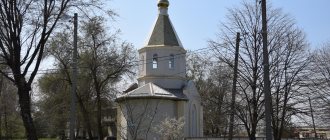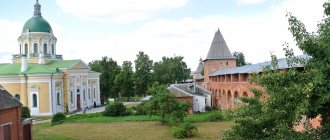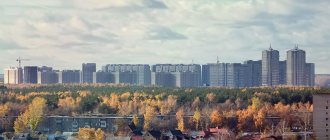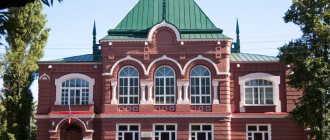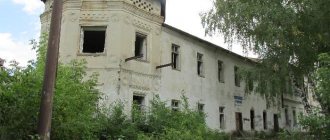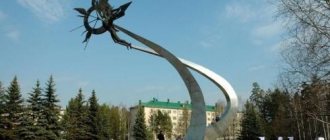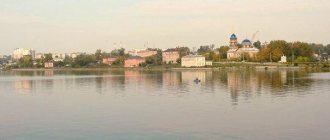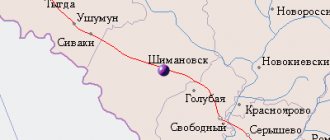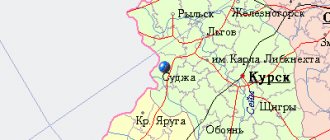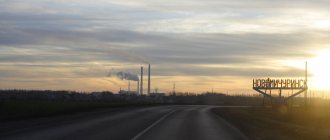This term has other meanings, see Zeya.
| City Zeya Coat of arms |
| A country | Russia, Russia |
| Subject of the federation | Amur RegionAmur Region |
| Urban district | Zeya city |
| Coordinates | 53°44′00″ n. w. 127°15′00″ E. long / 53.73333° north w. 127.25000° E. d./53.73333; 127.25000 (G) [www.openstreetmap.org/?mlat=53.73333&mlon=127.25000&zoom=12 (O)] (Z)Coordinates: 53°44′00″ N. w. 127°15′00″ E. long / 53.73333° north w. 127.25000° E. d./53.73333; 127.25000 (G) [www.openstreetmap.org/?mlat=53.73333&mlon=127.25000&zoom=12 (O)] (I) |
| Head of the city district | Matveev Sergey Alexandrovich |
| Based | 1879 |
| First mention | 1879 |
| Former names | until 1906 — Zeya Warehouse until 1913 - |
| City with | 1906 |
| Square | 45 km² |
| Center height | 220 |
| Population | ↘23,734[1] people (2016) |
| National composition | Russians and others |
| Confessional composition | Orthodox and other denominations |
| Names of residents | zeytsy (zeychane) |
| Timezone | UTC+9 |
| Telephone code | +7 41658 |
| Postcode | 676246 |
| Vehicle code | 28 |
| OKATO code | [classif.spb.ru/classificators/view/okt.php?st=A&kr=1&kod=10412 10 412] |
| Official site | [www.admzeya.ru/ zeya.ru] |
| Awards |
| Zeya Moscow |
| Blagoveshchensk Zeya |
K: Settlements founded in 1879
Zeya
- a city in the Amur region of Russia, the administrative center of the Zeya district and the urban district
of the city of Zeya
[2].
Population - 23,734[1] people. (2016), the territory of the city is 45 km².
Population
| Population | |||||
| 1913[3] | 1931[3] | 1939 | 1959[4] | 1970[5] | 1979[6] |
| 7400 | ↘6000 | ↗8900 | ↘7119 | ↗16 684 | ↗28 980 |
| 1989[7] | 1992[3] | 1996[3] | 1998[3] | 2002[8] | 2003[3] |
| ↗31 955 | ↗32 400 | ↘31 900 | ↘31 100 | ↘27 795 | ↗27 800 |
| 2005[3] | 2006[3] | 2007[3] | 2008[9] | 2009[10] | 2010[11] |
| ↘27 400 | ↘27 300 | ↘27 200 | ↘27 000 | ↘26 805 | ↘24 986 |
| 2011[12] | 2012[12] | 2013[13] | 2014[14] | 2015[15] | 2016[1] |
| ↘24 978 | ↘24 665 | ↘24 367 | ↘24 082 | ↘23 966 | ↘23 734 |
Fauna
Typical representatives of the taiga fauna live in the surrounding area:
- wapiti;
- roe;
- Ussuri elk;
- bear;
- boar;
- wolf;
- wolverine;
- raccoon dog;
- sable.
The ichthyofauna of the reservoir also has something to boast about; it includes the following species:
- minnow;
- Amur gudgeon;
- grayling;
- pike;
- whitefish;
- taimen;
- chebak;
- flathead asp;
- mustachioed loach.
Infrastructure
As of January 1, 2011, the city had 5 secondary schools, one of which has the status of a lyceum, and the other a municipal education center, 1 music school, a medical school (ZMMU), as well as the Pokrovsky Mining College (in the building of the closed vocational school No. 28) .
The city has cultural institutions: the Energetik sports center, the Rovesnik children's art house, a local history museum and the only museum of the history of gold mining in the region. There is a folk theater.
Fish and fishing
The Zeya River has a rich ichthyofauna. Many species of valuable fish live here, including taimen, large grayling and lenok. In addition to them, the river is inhabited by Amur chebak, silver crucian carp, vladislavia, pike, burbot, whitefish, etc. Despite the rich diversity of fish resources, legal industrial fishing is not developed on Zeya. And the spread of poaching, accompanied by the use of prohibited fishing means and massive fishing, leads to the depletion of the river’s natural reserves.
Climate
The city of Zeya is equated to the regions of the Far North.
- Average annual air temperature - −0.8 °C
- Relative air humidity - 74.3%
- Average wind speed - 1.6 m/s
| Average daily air temperature in Zeya according to NASA[16] | ||||||||||||
| Jan | Feb | Mar | Apr | May | Jun | Jul | Aug | Sep | Oct | But I | Dec | Year |
| −24.2 °C | −18.4 °C | −8.8 °C | 2.3 °C | 10.6 °C | 17.5 °C | 20.4 °C | 17.5 °C | 10.2 °C | −0.4 °C | −14.5 °C | −23.4 °C | −0.8 °C |
| Zeya Climate | |||||||||||||
| Index | Jan. | Feb. | March | Apr. | May | June | July | Aug. | Sep. | Oct. | Nov. | Dec. | Year |
| Absolute maximum | −0,5 | 7,2 | 13,9 | 25,3 | 34,0 | 34,7 | 40,0 | 35,5 | 28,1 | 21,0 | 6,2 | −1 | 40,0 |
| Average maximum, °C | −20,2 | −13,2 | −3,6 | 7,4 | 16,8 | 23,8 | 26,1 | 23,2 | 16,2 | 5,1 | −10,7 | −20 | 4,3 |
| Average temperature, °C | −25,9 | −20,2 | −10,2 | 1,6 | 10,3 | 17,1 | 20,0 | 17,1 | 9,8 | −0,9 | −16,4 | −25,1 | −1,8 |
| Average minimum, °C | −31,7 | −27,7 | −18,5 | −5,5 | 2,5 | 9,6 | 13,4 | 10,6 | 2,9 | −7,6 | −22,7 | −30,5 | −8,7 |
| Absolute minimum, °C | −47,8 | −46,1 | −38,9 | −26,1 | −8,6 | −3,9 | 2,2 | −1,5 | −10 | −30 | −42,2 | −48,9 | −48,9 |
| Precipitation rate | 5 | 8 | 10 | 23 | 48 | 91 | 135 | 109 | 79 | 23 | 18 | 8 | 557 |
| Source: [climatebase.ru/station/31300/ Zeya, Russian Federation]. Archive of climate data. [www.webcitation.org/67fzAMwRb Archived from the original on May 15, 2012]. | |||||||||||||
Attractions
The main attraction is the Zeya Nature Reserve. It occupies over 800 km² and is almost entirely located in the mountains. It features amazing species of animals, as well as 650-plus varieties of vascular plants.
In the place where the Gromotukha River flows into the Zeya, there is a historical monument - the dwelling of the Osinoozersk culture. Artifacts referencing the Neolithic Gromatukha culture were also discovered there.
Notes
- ↑ 123
www.gks.ru/free_doc/doc_2016/bul_dr/mun_obr2016.rar Population of the Russian Federation by municipalities as of January 1, 2016 - [admzeya.ru/doc/2011/Ustav.pdf Charter of the city of Zeya]
- ↑ 123456789
www.MojGorod.ru/amursk_obl/zeja/index.html People's encyclopedia “My City”. Zeya (city) - [demoscope.ru/weekly/ssp/rus59_reg2.php All-Union Population Census of 1959. The size of the urban population of the RSFSR, its territorial units, urban settlements and urban areas by gender] (Russian). Demoscope Weekly. Retrieved September 25, 2013. [www.webcitation.org/6GDOghWC9 Archived from the original on April 28, 2013].
- [demoscope.ru/weekly/ssp/rus70_reg2.php All-Union Population Census of 1970 The size of the urban population of the RSFSR, its territorial units, urban settlements and urban areas by gender.] (Russian). Demoscope Weekly. Retrieved September 25, 2013. [www.webcitation.org/6GDOiMstp Archived from the original on April 28, 2013].
- [demoscope.ru/weekly/ssp/rus79_reg2.php All-Union Population Census of 1979 The size of the urban population of the RSFSR, its territorial units, urban settlements and urban areas by gender.] (Russian). Demoscope Weekly. Retrieved September 25, 2013. [www.webcitation.org/6GDOjhZ5L Archived from the original on April 28, 2013].
- [demoscope.ru/weekly/ssp/rus89_reg2.php All-Union Population Census of 1989. Urban population]. [www.webcitation.org/617x0o0Pa Archived from the original on August 22, 2011].
- [www.perepis2002.ru/ct/doc/1_TOM_01_04.xls All-Russian Population Census 2002. Volume. 1, table 4. Population of Russia, federal districts, constituent entities of the Russian Federation, districts, urban settlements, rural settlements - regional centers and rural settlements with a population of 3 thousand or more]. [www.webcitation.org/65AdCU0q3 Archived from the original on February 3, 2012].
- [www.gks.ru/bgd/regl/b08_14t/IssWWW.exe/Stg/d/06-00.htm Cities of the Amur Region (number of inhabitants - estimate as of January 1, 2008, thousand people)]. Retrieved July 26, 2016. [www.webcitation.org/6jIRa1uI5 Archived from the original on July 26, 2016].
- [www.gks.ru/bgd/regl/B09_109/IssWWW.exe/Stg/d01/tabl-21-09.xls Number of permanent population of the Russian Federation by cities, urban-type settlements and districts as of January 1, 2009]. Retrieved January 2, 2014. [www.webcitation.org/6MJmu0z1u Archived from the original on January 2, 2014].
- amurstat.gks.ru/wps/wcm/connect/rosstat_ts/amurstat/resources/2b6753004d173f6bb358bbc5b34c73c1/chisl.xlsx All-Russian population census 2010. Population of urban districts, municipal districts, urban and rural settlements, urban settlements, rural settlements
- ↑ 12
www.gks.ru/dbscripts/munst/munst10/DBInet.cgi?pl=8112027 Amur region. Estimated resident population as of January 1, 2009-2014 - [www.gks.ru/free_doc/doc_2013/bul_dr/mun_obr2013.rar Population of the Russian Federation by municipalities as of January 1, 2013. - M.: Federal State Statistics Service Rosstat, 2013. - 528 p. (Table 33. Population of urban districts, municipal districts, urban and rural settlements, urban settlements, rural settlements)]. Retrieved November 16, 2013. [www.webcitation.org/6LAdCWSxH Archived from the original on November 16, 2013].
- [amurstat.gks.ru/wps/wcm/connect/rosstat_ts/amurstat/resources/0977a0004d173db4b2b9bbc5b34c73c1/07_1_4.htm Population estimate for urban districts, municipal districts, urban and rural settlements of the Amur Region as of January 1, 2014]. Retrieved March 27, 2014. [www.webcitation.org/6OOFpY4tZ Archived from the original on March 27, 2014].
- [www.gks.ru/free_doc/doc_2015/bul_dr/mun_obr2015.rar Population of the Russian Federation by municipalities as of January 1, 2015]. Retrieved August 6, 2015. [www.webcitation.org/6aaNzOlFO Archived from the original on August 6, 2015].
- [www.retscreen.net/ru/home.php NASA. RETScreen Database]
Economic use
The significant hydropower potential of Zeya (high water content, high coastal slopes), combined with the need to combat spring floods, led to the construction of the Zeya hydroelectric power station in the southern part of the Tukuringra ridge near the town of Zeya and the construction of a reservoir (1964 - 1985).
The main distinctive feature of the Zeya hydroelectric power station, which sets it apart from a number of large hydroelectric power stations in the Russian Federation, is the presence of rotary-blade diagonal (located at an angle of 45̊) turbines. This allows hydraulic units to generate energy when the water level in the reservoir is low in winter. Today, the installed capacity of the Zeya hydroelectric complex amounts to 1,330 kW, and the average annual electricity production reaches 4.95 billion kWh.
The Zeya Reservoir is one of the largest in the country. The area of its water surface is 2419 km2 (during spring floods this figure increases to 2584 km2), width - 25 km, depth in the lower part - up to 100 m. On average, about 27 - 28 km3 of water from the reservoir is spent on electricity generation, which corresponds to the average annual long-term runoff of Zeya.
Excerpt characterizing Zeya (city)
Prince Andrey wanted to leave immediately, but Princess Marya begged him to stay another day. On this day, Prince Andrei did not see his father, who did not go out and did not allow anyone to see him except M lle Bourienne and Tikhon, and asked several times whether his son had left. The next day, before leaving, Prince Andrei went to see his son's half. A healthy, curly-haired boy sat on his lap. Prince Andrei began to tell him the tale of Bluebeard, but, without finishing it, he became lost in thought. He was not thinking about this pretty boy son while he was holding him on his lap, but was thinking about himself. He searched in horror and found in himself neither remorse for having irritated his father, nor regret that he (in a quarrel for the first time in his life) was leaving him. The most important thing for him was that he was looking for and did not find that former tenderness for his son, which he hoped to arouse in himself by caressing the boy and sitting him on his lap. “Well, tell me,” said the son. Prince Andrei, without answering him, took him down from the pillars and left the room. As soon as Prince Andrei left his daily activities, especially as soon as he entered into the previous conditions of life in which he had been even when he was happy, the melancholy of life gripped him with the same force, and he hurried to quickly get away from these memories and find something to do quickly. – Are you going decisively, Andre? - his sister told him. “Thank God I can go,” said Prince Andrey, “I’m very sorry that you can’t.” - Why are you saying this! - said Princess Marya. - Why are you saying this now, when you are going to this terrible war and he is so old! M lle Bourienne said that he asked about you... - As soon as she began to talk about this, her lips trembled and tears began to fall. Prince Andrei turned away from her and began to walk around the room. - Oh my god! My God! - he said. – And just think about what and who – what insignificance can be the cause of people’s misfortune! - he said with anger, which frightened Princess Marya. She realized that, speaking about the people whom he called nonentities, he meant not only m lle Bourienne, who made him misfortune, but also the person who ruined his happiness. “Andre, I ask one thing, I beg you,” she said, touching his elbow and looking at him with shining eyes through tears. – I understand you (Princess Marya lowered her eyes). Don't think that it was people who caused the grief. People are his instrument. “She looked a little higher than Prince Andrei’s head with that confident, familiar look with which they look at a familiar place in a portrait. - The grief was sent to them, not people. People are his tools, they are not to blame. If it seems to you that someone is to blame for you, forget it and forgive. We have no right to punish. And you will understand the happiness of forgiving. – If I were a woman, I would do this, Marie. This is the virtue of a woman. But a man should not and cannot forget and forgive,” he said, and, although he had not thought about Kuragin until that moment, all the unresolved anger suddenly rose in his heart. “If Princess Marya is already trying to persuade me to forgive me, then it means I should have been punished a long time ago,” he thought. And, no longer answering Princess Marya, he now began to think about that joyful, angry moment when he would meet Kuragin, who (he knew) was in the army. Princess Marya begged her brother to wait another day, saying that she knew how unhappy her father would be if Andrei left without making peace with him; but Prince Andrei replied that he would probably soon come back from the army again, that he would certainly write to his father, and that now the longer he stayed, the more this discord would be fueled. – Adieu, Andre! Rappelez vous que les malheurs viennent de Dieu, et que les hommes ne sont jamais coupables, [Farewell, Andrey! Remember that misfortunes come from God and that people are never to blame.] - were the last words he heard from his sister when he said goodbye to her. “This is how it should be! - thought Prince Andrei, driving out of the alley of the Lysogorsk house. “She, a pitiful innocent creature, is left to be devoured by a crazy old man.” The old man feels that he is to blame, but cannot change himself. My boy is growing up and enjoying a life in which he will be the same as everyone else, deceived or deceiving. I'm going to the army, why? - I don’t know myself, and I want to meet that person whom I despise, in order to give him a chance to kill me and laugh at me! And before there were all the same living conditions, but before they were all connected with each other, but now everything has fallen apart. Some senseless phenomena, without any connection, one after another presented themselves to Prince Andrei. Prince Andrei arrived at the army headquarters at the end of June. The troops of the first army, the one with which the sovereign was located, were located in a fortified camp near Drissa; the troops of the second army retreated, trying to connect with the first army, from which - as they said - they were cut off by large forces of the French. Everyone was dissatisfied with the general course of military affairs in the Russian army; but no one thought about the danger of an invasion of the Russian provinces, no one imagined that the war could be transferred further than the western Polish provinces. Prince Andrei found Barclay de Tolly, to whom he was assigned, on the banks of the Drissa. Since there was not a single large village or town in the vicinity of the camp, the entire huge number of generals and courtiers who were with the army were located in a circle of ten miles in the best houses of the villages, on this and on the other side of the river. Barclay de Tolly stood four miles from the sovereign. He received Bolkonsky dryly and coldly and said in his German accent that he would report him to the sovereign to determine his appointment, and in the meantime he asked him to be at his headquarters. Anatoly Kuragin, whom Prince Andrei hoped to find in the army, was not here: he was in St. Petersburg, and this news was pleasant for Bolkonsky. Prince Andrei was interested in the center of the huge war taking place, and he was glad to be free for a while from the irritation that the thought of Kuragin produced in him. During the first four days, during which he was not required anywhere, Prince Andrey traveled around the entire fortified camp and, with the help of his knowledge and conversations with knowledgeable people, tried to form a definite concept about him. But the question of whether this camp was profitable or unprofitable remained unresolved for Prince Andrei. He had already managed to derive from his military experience the conviction that in military affairs the most thoughtfully thought-out plans mean nothing (as he saw it in the Austerlitz campaign), that everything depends on how one responds to unexpected and unforeseen actions of the enemy, that everything depends on how and by whom the whole business is conducted. In order to clarify this last question, Prince Andrei, taking advantage of his position and acquaintances, tried to understand the nature of the administration of the army, the persons and parties participating in it, and derived for himself the following concept of the state of affairs.
Settlements
There are a huge number of settlements on the coast, the largest of which are:
- Zeya;
- Blagoveshchensk;
- Novokievsky Uval;
- Free.
In addition to these cities, along the coastline there are also:
- Zarechnaya Sloboda;
- Pinery;
- Nikolaevka-2;
- Alexandrovka;
- Nikolaevka;
- Oatmeal;
- Alekseevka;
- Berezovka;
- Algach;
- Mazanovo;
- Practical;
- Beloyarovo;
- Novonikolsk;
- Kamenka;
- Zagan;
- Zheltoyarovo;
- Novoandreevka;
- Pryadchino;
- Novopetrovka;
- Yegoryevka;
- Ust-Ivanovka;
- Vladimirovka;
- Semiozerka;
- Mukhinka.
Tributaries
The river's catchment includes almost 30 thousand tributaries (and only 43 of them have a channel length of more than 100 km) and about 20 thousand lakes. Let us list the most significant tributaries of the Zeya River.
| Tributary name | On which side of the Zeya River is the branch located? | Channel length, km | Distance from the mouth, km |
| Selemdzha | left tributary | 647 | 284 |
| Gilyuy | right tributary | 545 | 680 |
| Tom | left tributary | 433 | 110 |
| Argi | left tributary | 350 | 939 |
| Dep | left tributary | 348 | 485 |
| Bryanta | right tributary | 317 | 791 |
| Urkan lower | right tributary | 304 | 588 |
| Tygda | right tributary | 264 | 447 |
| Current | right tributary | 251 | 946 |
| Urkan upper | left tributary | 234 | 878 |
| Mulmuga | right tributary | 234 | 837 |
| Ivanovka | left tributary | 176 | 21 |
| Kupuri | left tributary | 162 | 1073 |
Ecology
There are 5 sand mining sites on the Zeya coast, but this does not save the river from river sand thieves. In the past, every year with the onset of cold weather, illegal activities began, which were destructive to the river’s ecosystem. As a result of such actions, the landscape of the coastline was actively changing.
Now the activity has been brought under control and mass thefts have stopped, but in remote areas it can still be seen. Of course, the effect will not be long in coming: slowly but surely the banks will begin to crumble, the river will become shallow, the groundwater level will drop, and the number of fish will decrease.
Flora
The flora of the river changes from the upper reaches to the lower reaches of the reservoir. Thus, at the source, near which the Zeya Nature Reserve is located, about 650 species of plants and almost 60 species of mushrooms grow. Typical species are Mongolian oak, Amur linden, berry apple tree, variegated hazel, Japanese elm, Siberian mountain ash, brown willow, cloudberry, dwarf cedar, and dwarf birch.
Closer to the middle of the channel, the deciduous thickets thin out and give way to dark conifers, which are mainly formed by Ayan spruce.
And the closer to the mouth, the more meadows are scattered along the banks, and wetlands are often found.
